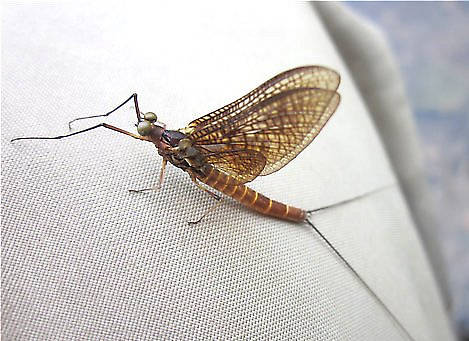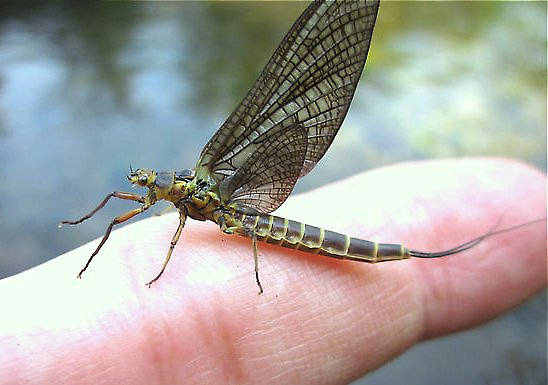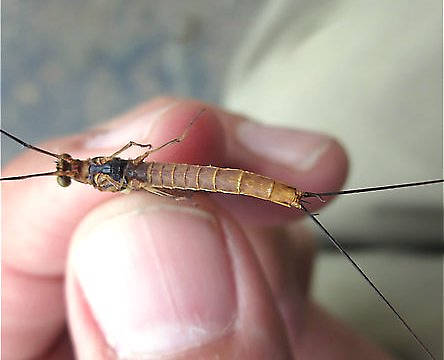
Salmonflies
Pteronarcys californica
The giant Salmonflies of the Western mountains are legendary for their proclivity to elicit consistent dry-fly action and ferocious strikes.
Featured on the forum

Some characteristics from the microscope images for the tentative species id: The postero-lateral projections are found only on segment 9, not segment 8. Based on the key in Jacobus et al. (2014), it appears to key to Neoleptophlebia adoptiva or Neoleptophlebia heteronea, same as this specimen with pretty different abdominal markings. However, distinguishing between those calls for comparing the lengths of the second and third segment of the labial palp, and this one (like the other one) only seems to have two segments. So I'm stuck on them both. It's likely that the fact that they're immature nymphs stymies identification in some important way.

Troutnut is a project started in 2003 by salmonid ecologist Jason "Troutnut" Neuswanger to help anglers and
fly tyers unabashedly embrace the entomological side of the sport. Learn more about Troutnut or
support the project for an enhanced experience here.
Mayfly Genus Litobrancha
This genus is very closely related to Hexagenia. Its only species, Litobrancha recurvata, can be quite important.
Where & when
In 9 records from GBIF, adults of this genus have been collected during June (44%), July (44%), and May (11%).
Genus Range
Specimens of the Mayfly Genus Litobrancha
1 Male Dun

These photos were contributed by Spencer Vanderhoof.
1 Female Dun

These photos were contributed by Spencer Vanderhoof.
1 Male Spinner

These photos were contributed by Spencer Vanderhoof.
Discussions of Litobrancha
Something like recurvata, but different.
8 replies
Posted by DayTripper on Apr 6, 2013 in the species Litobrancha recurvata
Last reply on Apr 14, 2013 by Oldredbarn
Okay, I'm at a local TU meeting and a friend tells me about a double secret mystery hex hatch. According to him, these hex are colored differently than our limbata, hatch two or three weeks earlier for about 3 days only (last week of May or the first week of June), and exhibit some other "different" behavior traits. Needless to say, I was interested in learning more. Fast forward to this morning when I picked one of the nymphs up from his house after he dug a sample up for me to take home. Its still alive, so I'm trying to figure out what body parts I need photographs of to share here to see what you guys think this guy is.
A quick look at the head and tusks is pointing me to Litobrancha recurvata, and the emergence period shown in Hatches II for them is about right (May 14 to July 3). The photo they have in their color plates looks very close to what I just finished photographing, but what I have looks different.
I took a couple dozen quick photos of it and uploaded them to my flickr account, wasn't sure if it was ok or necessary to upload them all here. Link to the gallery below. Please let me know if you'd like me to upload any of these here, or if you'd like a better shot of a certain feature, so you can see the full res photo for better detail. In my non-expert opinion, I would say this nymph is near full maturity, as its ginormous. I can't find my metric ruler, but it is ~50mm long. Thanks for any help.
http://www.flickr.com/photos/cerveniak/sets/72157633180659254/
Alex
A quick look at the head and tusks is pointing me to Litobrancha recurvata, and the emergence period shown in Hatches II for them is about right (May 14 to July 3). The photo they have in their color plates looks very close to what I just finished photographing, but what I have looks different.
I took a couple dozen quick photos of it and uploaded them to my flickr account, wasn't sure if it was ok or necessary to upload them all here. Link to the gallery below. Please let me know if you'd like me to upload any of these here, or if you'd like a better shot of a certain feature, so you can see the full res photo for better detail. In my non-expert opinion, I would say this nymph is near full maturity, as its ginormous. I can't find my metric ruler, but it is ~50mm long. Thanks for any help.
http://www.flickr.com/photos/cerveniak/sets/72157633180659254/
Alex
Litobrancha recurvata
4 replies
Posted by Crepuscular on May 14, 2012 in the species Litobrancha recurvata
Last reply on May 14, 2012 by Crepuscular
Litobrancha in Minnesota
5 replies
Posted by Dryfly on Aug 29, 2009
Last reply on Aug 30, 2009 by GONZO
Sorry no photo
While out fishing I came across a big drake spinner. I think it might be Litobrancha Recurvata. 2 tails 17 mm body length, front pair of legs darker than back two, olive abdomen, darker thorax. Collected August 28th, which is relatively late for Litobrancha. Also could be Hexagenia Rigida or Atrocaudata.
Anyone know if Litobrancha or the Late Hexs are present in Southeast Mn?
While out fishing I came across a big drake spinner. I think it might be Litobrancha Recurvata. 2 tails 17 mm body length, front pair of legs darker than back two, olive abdomen, darker thorax. Collected August 28th, which is relatively late for Litobrancha. Also could be Hexagenia Rigida or Atrocaudata.
Anyone know if Litobrancha or the Late Hexs are present in Southeast Mn?
I agree with the nymph and emergence coments above
Posted by Beardius on Aug 1, 2008 in the species Litobrancha recurvata
Last reply on Aug 1, 2008 by Beardius
Caucci and Nastasi's comments and other comments above are correct. They are really hardy and impressive nymphs when they near maturity. Litobrancha nymphs prefer fine silty, mucky habitats in streams. They can be abundant in mucky side channels to the main stream. Their emergence occurs over a 5-day span, with the large majority emerging within a 3-day period. Therefore, large emergences are rarely encountered. When they do occur, they can be very impressive.
From my experience collecting and rearing these critters, they have a 2-year life cycle in PA and MD. They increase tremendously in size in their second year. Emergence occurred in late May into early June about a week before that of green drakes (Ephemera guttulata).
From my experience collecting and rearing these critters, they have a 2-year life cycle in PA and MD. They increase tremendously in size in their second year. Emergence occurred in late May into early June about a week before that of green drakes (Ephemera guttulata).
Start a Discussion of Litobrancha
References
- Jacobus, L. M., Wiersema, N.A., and Webb, J.M. 2014. Identification of Far Northern and Western North American Mayfly Larvae (Insecta: Ephemeroptera), North of Mexico; Version 2. Joint Aquatic Science meeting, Portland, OR. Unpublished workshop manual. 1-176.
Mayfly Genus Litobrancha
Taxonomy
Species in Litobrancha
Litobrancha recurvataDark Green Drakes
3
4
Species in Litobrancha: Litobrancha recurvata





